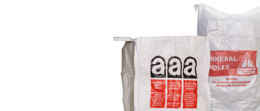Hazardous material information
Types of packaging
(by packaging group classes according to ADR) General provisions and regulations for dangerous substances and articles in the ADR excerpt; no claim to completeness. Definitions Subject to the special regulations for the individual dangerous goods classes, the following packaging may be used:
Outer packaging:
The outer protection of a combination or composite packaging, including substances with absorbent properties, cushioning materials and any other components necessary to enclose and protect inner receptacles or inner packagings.
Salvage packaging:
Special packaging which complies with the applicable provisions of Chapter 6.1 (ADR) and in which damaged, defective or leaking packages containing dangerous goods or dangerous goods which have spilled or leaked are placed for the purpose of transporting them for recovery or disposal.
Container:
a transport appliance (frame structure or similar appliance) which is of a permanent nature and therefore sufficiently strong to be capable of repeated use, which is specially designed to facilitate the carriage of goods by one or more modes of transport without altering the load, which is fitted with devices to facilitate securing and handling, particularly during transfer from one means of transport to another, which is so constructed as to facilitate transfer from one means of transport to another.
Note: The term container does not include standard packaging, IBCs, tank containers or vehicles.
Barrel:
Cylindrical packaging made of metal, cardboard, plastic, plywood or another suitable material with flat or curved bottoms. This term also includes packaging of other shapes, e.g. round packaging with a conical neck or bucket-shaped packaging. This term does not include wooden drums and canisters.
Ultra-thin sheet metal packaging:
Packaging with a round, elliptical, rectangular or polygonal cross-section (including conical) and packaging with a conical neck or bucket-shaped packaging made of metal with a wall thickness of less than 0.5 mm (e.g. tinplate), with flat or domed bottoms, with one or more openings, which is not covered by the definition of drum or canister.
Cylinder:
Transportable pressure container with a capacity of up to 150 liters.
Flexible intermediate bulk container (IBC):
A intermediate bulk container consisting of a packaging body provided with suitable handling equipment and handling devices, formed from a film, fabric or other flexible material or compositions of such materials, with an internal coating or lining where required.
IBCs:
Rigid or flexible, transportable packaging which is not listed in Chapter 6.1 (ADR) and:
a) has a maximum capacity of 3.0 m_ for solids and liquids of packing groups II + III, maximum 1.5 m_ for solids of packing group I, provided they are packed in flexible IBCs, plastic IBCs,
combination IBCs, cardboard or wooden IBCs, maximum 3.0 m_ for solids of packing group I, if packed in metal IBCs, maximum 3.0 m_ for radioactive material of class 7,
b) is designed for mechanical handling;
c) can withstand the stresses of handling and transportation, as confirmed by the tests specified in Chapter 6.5 ADR)
Note 1 Tank-containers complying with the provisions of Chapter 6.7 or 6.8 (ADR) are not considered as intermediate bulk containers.
2. intermediate bulk containers (IBCs) which comply with the provisions of Chapter 6.8 are not considered to be containers within the meaning of ADR.
Wooden barrel:
Packaging made of natural wood with a round cross-section and bulbous walls, consisting of staves and bottoms and fitted with hoops.
IBC:
See intermediate bulk containers.
Inner container:
Container that requires outer packaging in order to fulfill its container function.
Inner packaging:
Packaging that requires outer packaging for transportation.
Canister:
Packaging made of metal or plastic of rectangular or polygonal cross-section with one or more openings.
Crate:
Rectangular or polygonal solid-walled packaging made of metal, wood, plywood, wood fiber material, cardboard, plastic or other suitable material. Provided the integrity of the packaging is not compromised during transportation, small openings may be made to facilitate handling or opening or to meet the classification criteria.
Combination IBC with plastic inner container:
An IBC consisting of a frame in the form of a rigid outer shell around a plastics inner receptacle with the service or other structural equipment. It is designed so that the inner receptacle and the outer casing form an inseparable unit by composition, which is filled, stored, transported or emptied as such.
Note: When the term "plastics" is used in relation to inner receptacles of composite IBCs, it also includes other polymeric materials such as rubber, etc.
Combination packaging (plastic):
Packaging consisting of a plastic inner container and an outer packaging (made of metal, cardboard, plywood, etc.). Once assembled, it forms an inseparable unit which is filled, stored, transported and emptied as such.
Note See note. For "Combination packaging (glass, porcelain or stoneware)"
Combination packaging (glass, porcelain or stoneware):
Packaging consisting of an inner container made of glass, porcelain or stoneware and an outer packaging (made of metal, wood, cardboard, plastic, foam, etc.). Once assembled, it forms an inseparable unit which is filled, stored, transported and emptied as such.
Note: The inner part of the combination packaging is normally referred to as the "inner container". For example, the "inner part" of a 6HA1 combination pack (plastic) is such an "inner receptacle" as it is not normally intended to perform a container function without its outer packaging, therefore it is not an "inner packaging".
Reconditioned packaging:
Packaging, in particular
a) a metal drum:
which has been cleaned so as to restore the materials of construction to their original appearance, removing all remnants of the former contents, as well as internal and external corrosion and external coatings and stains, which has been restored to its original shape and profile, with the seams (if any) straightened and sealed and all seals replaced, which are not an integral part of the packaging have been replaced, and which has been inspected after cleaning but before repainting, whereby packaging with visible small holes, a significant reduction in material thickness, metal fatigue, damaged threads or closures or other significant defects must be rejected;
b) a plastic drum or canister:
Which has been cleaned to restore the materials of construction to their original appearance, removing all remnants of previous contents and external coatings and labeling;
whose seals, which are not an integral part of the packaging, have been replaced and which has been inspected after cleaning, whereby packaging which shows visible damage, such as cracks, folds or breaks, or damaged threads or closures or other significant defects, must be rejected.
Sack:
Flexible packaging made of paper, plastic film, textiles, woven or other suitable materials.
Closure:
A device used to close the opening of a container.
Composite packaging:
Packaging assembled for transportation, consisting of one or more inner packagings which must be inserted into an outer packaging in accordance with 4.1.3.1 (ADR). Note. The "inner part" of the combination packaging is always referred to as the "inner packaging", not the "inner receptacle". A glass bottle is an example of such an inner packaging.
Important terms:
(according to Annex A General provisions and regulations for dangerous substances and articles in the ADR) Excerpt; no claim to completeness
ADR:
European Agreement concerning the International Carriage of Dangerous Goods by Road
Solid substance:
A substance with a melting point or onset of melting above 20 °C at a pressure of 101.3 kPa or a substance that is not liquid according to the ASTM D 4359-90 test method or is viscous according to the criteria of the test method for determining flow behavior (penetrometer method) described in section 2.3.4 (ADR). Solid substance.
Flash point:
The lowest temperature of a liquid substance at which its vapors form a flammable mixture with air.
Liquid substance:
A substance which has a vapor pressure of not more than 300 kPa (3 bar) at 50 °C and is not completely gaseous at 20 °C and a pressure of 101.3 kPa and which has a melting point or onset of melting of 20 °C or below at a pressure of 1013 kPa or is liquid according to the ASTM D 4359-90 test method or is not viscous according to the criteria of the test method for the determination of flow behavior (penetrometer method) described in section 2.3.4 (ADR). Liquid substance.
Dangerous goods class:
Classification of dangerous goods into different classes. Dangerous goods class.
GGVE:
Ordinance on the national and international transportation of dangerous goods by rail. GGVE = Dangerous Goods Ordinance for Railways.
GGVS:
Ordinance on the national and international carriage of dangerous goods by road. GGVS = Dangerous Goods Ordinance Road.
GGVSee:
Regulation on the carriage of dangerous goods by sea-going vessels. GGVSee = Dangerous Goods Ordinance Sea
Highest net mass:
The highest net mass of the contents of a single package or the highest sum of the masses of the inner packages and their contents, expressed in kilograms.
Maximum capacity:
The highest internal volume of receptacles or packagings, including intermediate bulk containers (IBCs) and large packagings, expressed in m_ or liters.
Maximum gross mass:
(a) (for all types of IBCs except flexible IBCs): Mass of the body of the packaging material, its service equipment, its structural equipment and its maximum authorized load for carriage.
(b) (for tanks): the sum of the net mass of the tank and the maximum load authorized for carriage.
IATA:
International Dangerous Goods Regulations for the transportation of dangerous goods by air worldwide. IATA.
IMDG Code:
International Maritime Dangerous Goods Code, Regulations for the Application of Chapter VII, Part A of the International Convention for the Safety of Life at Sea, 1974 (SOLAS Convention), issued by the International Maritime Organization (IMO), London. IMDG Code.
Inner liner:
A tubular envelope or sack which is inserted into, but is not an integral part of, a packaging, including a large packaging or IBC, including the means of closing its openings.
Test pressure:
Highest effective pressure that occurs in the tank during the pressure test.
RID:
Regulations concerning the International Carriage of Dangerous Goods by Rail [Annex I to Appendix B ADR (Uniform Rules concerning the Contract for International Carriage of Goods by Rail) (CIM) of COTIF (Convention concerning International Carriage by Rail)]. RID.
UN Model Regulations:
The Model Regulations contained in the Annex to the eleventh revised edition of the UN Recommendations on the Transport of Dangerous Goods, issued by the United Nations (ST/SG/AC.10/1/Rev.11).
UN number:
Four-digit number used to identify substances or articles in accordance with UN model regulations.
Packing group:
A group to which certain substances are assigned for packaging purposes on the basis of their degree of danger during transportation. The packing groups have the following meaning, which is explained in more detail in Part 2 of the ADR: Packing group.
Packing group I: Substances with high hazard
Packing group II: Substances with medium hazard
Packing group III: Substances with low hazard
Note: Certain articles containing dangerous substances are also assigned to a packing group.
Source ADR (excerpt)
Disclaimer of liability:
This service, which we make available to you free of charge, does not guarantee that the information provided is complete, correct and up-to-date in every case. As a user of this service, it is your responsibility to check the information provided yourself. You are responsible for implementing the knowledge gained at your own discretion.








